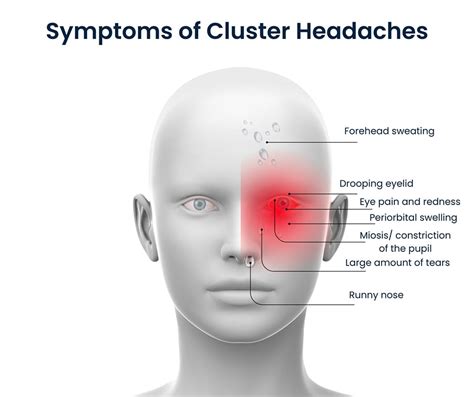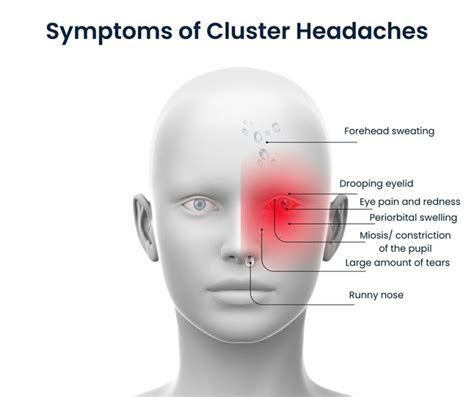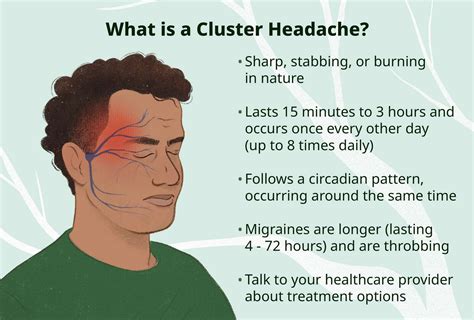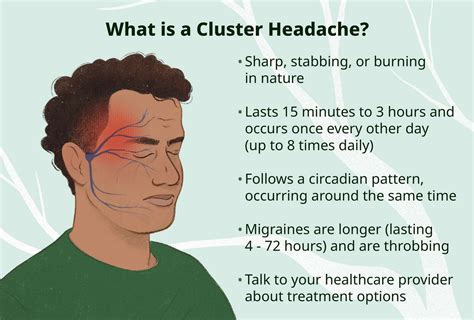Intro
Learn about cluster headaches, a rare headache disorder, and its symptoms, causes, and treatments, including pain management and prevention strategies for this debilitating condition.
Cluster headaches are a type of headache disorder that is known for its intense, debilitating pain. They are relatively rare, affecting only about 1 in 1,000 people, but for those who experience them, the impact can be significant. Cluster headaches are often described as the most painful type of headache, even more so than migraines. The pain is typically centered on one side of the head, often around the eye, and can be accompanied by other symptoms such as nasal congestion, eye watering, and sensitivity to light and sound.
The exact cause of cluster headaches is not fully understood, but research suggests that they may be related to abnormalities in the brain's blood vessels and nerve pathways. Some people may be more prone to cluster headaches due to genetic factors, while others may experience them as a result of environmental or lifestyle factors. For example, changes in sleep patterns, stress, and certain medications may trigger cluster headaches in some individuals. Understanding the potential causes and triggers of cluster headaches is essential for developing effective treatment and management strategies.
Cluster headaches can have a significant impact on a person's quality of life, making it essential to seek medical attention if symptoms persist or worsen over time. A proper diagnosis by a healthcare professional is crucial to determine the best course of treatment. In some cases, cluster headaches may be mistaken for other types of headaches or conditions, such as migraines or sinusitis, so a thorough evaluation is necessary to ensure accurate diagnosis and treatment. With the right treatment and support, it is possible to manage cluster headaches and reduce their frequency and severity.
What are Cluster Headaches?

Cluster headaches are a type of primary headache disorder, meaning that they are not caused by another underlying medical condition. They are characterized by severe, unilateral pain, typically centered around the eye, and can be accompanied by other symptoms such as nasal congestion, eye watering, and sensitivity to light and sound. The pain of a cluster headache is often described as burning, piercing, or stabbing, and can be so severe that it interferes with daily activities.
Types of Cluster Headaches
There are two main types of cluster headaches: episodic and chronic. Episodic cluster headaches occur in cycles or clusters, with periods of frequent headaches followed by periods of remission. Chronic cluster headaches, on the other hand, occur regularly, without significant periods of remission. Understanding the type of cluster headache is essential for developing an effective treatment plan.Symptoms of Cluster Headaches

The symptoms of cluster headaches can vary from person to person, but common symptoms include:
- Severe, unilateral pain, typically centered around the eye
- Nasal congestion or runny nose
- Eye watering or redness
- Sensitivity to light and sound
- Restlessness or agitation
- Sweating or flushing of the face
- Drooping or swelling of the eyelid
Triggers of Cluster Headaches
While the exact cause of cluster headaches is not fully understood, certain triggers may contribute to their development. These triggers can include: * Changes in sleep patterns * Stress * Certain medications * Hormonal changes * Weather changes * Altitude changesDiagnosis of Cluster Headaches

Diagnosing cluster headaches can be challenging, as the symptoms can be similar to those of other headache disorders. A healthcare professional will typically perform a physical examination, take a medical history, and may order imaging tests such as a CT or MRI scan to rule out other conditions. A diagnosis of cluster headaches is typically made based on the presence of characteristic symptoms and the absence of other underlying medical conditions.
Treatment Options for Cluster Headaches
Treatment for cluster headaches typically involves a combination of medications and lifestyle changes. Medications may include: * Triptans or other pain-relieving medications * Corticosteroids to reduce inflammation * Oxygen therapy to help relieve pain * Preventive medications such as verapamil or topiramateLifestyle changes may include:
- Maintaining a consistent sleep schedule
- Avoiding triggers such as stress or certain medications
- Staying hydrated and avoiding dehydration
- Avoiding heavy exercise or physical activity during a cluster headache episode
Living with Cluster Headaches

Living with cluster headaches can be challenging, but there are steps that can be taken to manage symptoms and reduce their impact on daily life. This may include:
- Keeping a headache diary to track symptoms and identify triggers
- Developing a treatment plan with a healthcare professional
- Staying connected with friends and family for support
- Engaging in stress-reducing activities such as meditation or yoga
- Getting regular exercise and maintaining a healthy diet
Coping with Cluster Headaches
Coping with cluster headaches requires a combination of medical treatment, lifestyle changes, and emotional support. It is essential to work with a healthcare professional to develop a personalized treatment plan and to stay connected with friends and family for support. Additionally, engaging in stress-reducing activities and maintaining a healthy lifestyle can help reduce the frequency and severity of cluster headaches.Future Directions for Cluster Headache Research

Research into cluster headaches is ongoing, with scientists working to better understand the underlying causes and develop more effective treatments. Future directions for research may include:
- Investigating the role of genetics in cluster headaches
- Developing new medications or therapies to treat cluster headaches
- Exploring the use of alternative therapies such as acupuncture or herbal supplements
- Improving our understanding of the relationship between cluster headaches and other medical conditions
Current Research and Developments
Current research into cluster headaches is focused on improving our understanding of the underlying causes and developing more effective treatments. This includes investigating the role of genetics, developing new medications, and exploring the use of alternative therapies. Additionally, researchers are working to improve our understanding of the relationship between cluster headaches and other medical conditions, such as migraines and sinusitis.Conclusion and Next Steps

In conclusion, cluster headaches are a complex and debilitating condition that requires a comprehensive treatment approach. By understanding the symptoms, triggers, and treatment options, individuals with cluster headaches can work with their healthcare professional to develop a personalized treatment plan. Additionally, ongoing research into the underlying causes and development of new treatments offers hope for improved management and reduction of symptoms.
If you or someone you know is experiencing symptoms of cluster headaches, it is essential to seek medical attention to receive a proper diagnosis and treatment. With the right treatment and support, it is possible to manage cluster headaches and reduce their impact on daily life.
What are the symptoms of cluster headaches?
+The symptoms of cluster headaches can include severe, unilateral pain, typically centered around the eye, as well as nasal congestion, eye watering, and sensitivity to light and sound.
How are cluster headaches diagnosed?
+Diagnosing cluster headaches can be challenging, but a healthcare professional will typically perform a physical examination, take a medical history, and may order imaging tests such as a CT or MRI scan to rule out other conditions.
What are the treatment options for cluster headaches?
+Treatment for cluster headaches typically involves a combination of medications and lifestyle changes, including triptans or other pain-relieving medications, corticosteroids, oxygen therapy, and preventive medications such as verapamil or topiramate.
Can cluster headaches be prevented?
+While cluster headaches cannot be completely prevented, certain lifestyle changes such as maintaining a consistent sleep schedule, avoiding triggers, and staying hydrated may help reduce their frequency and severity.
What is the prognosis for cluster headaches?
+The prognosis for cluster headaches varies depending on the individual and the effectiveness of treatment. With proper treatment and management, it is possible to reduce the frequency and severity of cluster headaches and improve quality of life.
We hope this article has provided you with a comprehensive understanding of cluster headaches, their symptoms, diagnosis, treatment options, and management strategies. If you have any further questions or concerns, please do not hesitate to reach out to a healthcare professional. Additionally, we invite you to share your experiences and comments below, and to share this article with others who may be affected by cluster headaches. Together, we can work towards improving our understanding and management of this complex condition.
